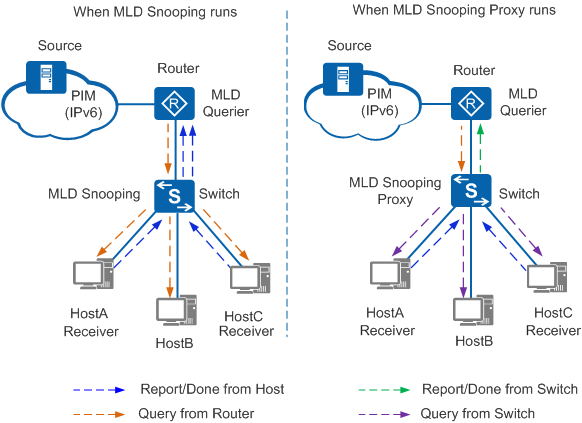MLD Snooping Proxy
Fundamentals
MLD snooping proxy can be configured on a Layer 2 device, which then s a host for the upstream Layer 3 device and a querier for downstream hosts. This reduces the number of MLD Report and Done messages sent to the upstream Layer 3 device.
In Figure 1, when the switch runs MLD snooping, it transparently forwards MLD Query, Report, and Done messages to the upstream router. If numerous hosts exist on the network, redundant MLD messages increase router resource usage.
With MLD snooping proxy configured, the switch terminates MLD Query messages sent from the router and MLD Report/Done messages sent from hosts. Upon receiving these messages, the switch constructs new messages to send them to the router or hosts.
After MLD snooping proxy is configured on the switch, the router detects only one user, and the switch interacts with both the router and hosts. This conserves network bandwidth by reducing the number of MLD messages exchanged. Additionally, the switch acts as a querier to process protocol messages received from hosts and maintain group memberships. This reduces resource consumption on the router.
Implementation
A device with MLD snooping proxy configured creates and maintains a Layer 2 multicast forwarding table, based on which it sends multicast data to hosts. Table 1 describes how this device processes received MLD messages.
MLD Message Type |
Processing Method |
|---|---|
MLD General Query |
The Layer 2 device forwards the message to all ports excluding the port that has received the message. The device constructs an MLD Report message based on the group membership and sends it to all router ports. |
Multicast-Address-Specific Query/Multicast Address and Source Specific Query |
If the group specified in the message has member ports in the multicast forwarding table, the Layer 2 device responds with an MLD Report message to all router ports. |
MLD Report |
|
MLD Done |
The Layer 2 device sends a Group-Specific Query message to the port that received the MLD Done message. The device sends an MLD Done message to all router ports only after the last member port is deleted from the forwarding entry. |
